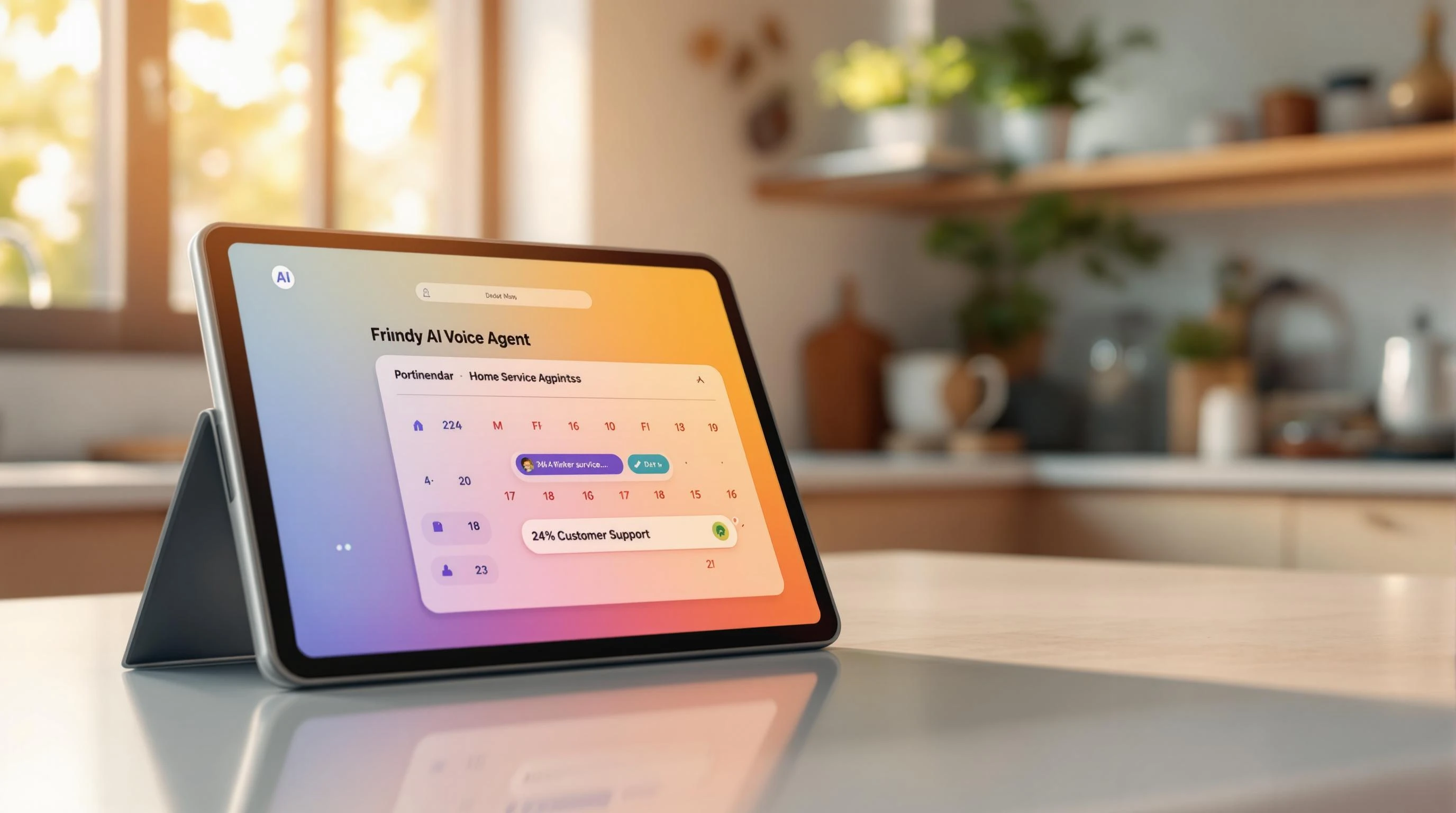
Feb 24, 2025
6 min read
AI call answering systems are transforming how small businesses handle customer calls by reducing costs, improving efficiency, and ensuring 24/7 availability. Over 62% of small business calls go unanswered, leading to lost revenue and frustrated customers. AI solutions solve this by automating routine tasks, cutting operational costs by up to 95%, and boosting customer satisfaction by 20%.
Key Benefits:
Cost Savings: Replaces full-time receptionists, starting at $49/month.
24/7 Availability: No missed calls, even outside business hours.
Efficiency: Reduces staff workload by 50% and speeds up response times.
Scalability: Handles multiple calls simultaneously.
Customization: Supports multiple languages and integrates with tools like CRMs.
Popular AI Call Systems:
Simple Phones: $49/month, 100 calls, intelligent routing.
IsOn24: $49/month, 1000 minutes, appointment scheduling.
Goodcall: $59/month, unlimited calls, GPT-powered.
WePickUpThePhone: €99/month, multilingual support, real-time analytics.
Quick Comparison:
AI call systems are affordable, easy to set up, and customizable to your business needs. Start by defining your goals, selecting the right platform, and integrating it with your tools to improve customer communication and streamline operations.
How AI Call Answering Works
AI call answering systems rely on Natural Language Processing (NLP) and Automatic Speech Recognition (ASR) to enable smooth, conversational interactions. This evolution from rigid menus to more fluid exchanges offers businesses a new level of efficiency.
Main Functions of AI Phone Systems
AI phone systems operate through several core processes:
For example, OpenCall leveraged Cerebras' LLM inference API to cut response times by 90% and boost customer satisfaction scores from 7.5 to 9.4 .
AI vs. Human Answering Services: Cost and Performance
AI systems significantly lower costs by replacing the need for full-time receptionists. Here's how they compare to human-operated services:
AI systems shine in handling common inquiries, like WISMO (Where Is My Order) calls, which account for 35% of customer support interactions in retail . This automation frees human agents to tackle more nuanced issues.
CNH Care illustrates this efficiency well. By automating ticket routing and reducing wait times, they achieved a 96% customer satisfaction score . This shows how AI can enhance service quality while keeping operations streamlined for small businesses.
Budget-Friendly AI Call Systems for Small Businesses
Affordable AI call systems now bring high-end features to small businesses without breaking the bank. Here’s a closer look at some practical solutions and what they offer.
WePickUpThePhone Voice Agents

WePickUpThePhone provides an AI-powered voice agent platform with pricing tiers that cater to small business budgets:
One standout feature is its support for over 200 voices in 32 languages, making it a great fit for businesses serving multilingual communities. It also integrates easily with existing tools and provides real-time analytics to monitor performance.
Other Options: Simple Phones, IsOn24, and Goodcall

If you’re looking for alternatives, here are a few other platforms worth considering:
Simple Phones: Starting at $49/month for 100 calls, this system uses intelligent call routing to automate frequent requests. They may also offer a 30% discount for the first three months .
IsOn24: At $49/month, you get 1000 minutes, text messaging, and online replies. The system mimics human-like conversations and can handle appointment scheduling .
Goodcall: Priced at $59/month (or $41/month if billed annually), this GPT-powered platform manages unlimited simultaneous calls, appointments, and text messaging .
Comparing AI Call System Features
Here’s a side-by-side comparison of what these platforms bring to the table:
Choose the platform that aligns with your business needs and budget for the best results.
Setting Up AI Call Answering
Getting an AI call answering system up and running involves a few key steps. Let’s walk through what you need to know to make the process smooth and effective.
Setup Guide
Start by defining your goals and analyzing call patterns. Research shows that 93% of companies save time, and 83% cut costs by adopting AI systems .
Here’s a breakdown of the process:
1. Requirements Analysis
Decide what you want to achieve - whether it’s automating customer support, scheduling appointments, or managing sales calls. Gather data on your current call volumes, peak times, and frequently asked questions. This information will help you fine-tune the system.
2. System Selection and Integration
Pick a platform that works well with your existing tools. For example, WePickUpThePhone integrates easily with popular CRM systems and offers over 200 voice options in 32 languages, making it highly versatile.
3. Initial Configuration
Set up the system by configuring:
Call routing rules
Business hours
Voice preferences
Response scripts
CRM and other tool integrations
Once the setup is complete, the focus shifts to training your team to use the system effectively.
System Setup Tips
Tailor the system to align with your brand. Here are some ways to make it work for you:
Voice and Tone Configuration
Choose a voice that fits your brand’s personality.
Create personalized greetings for different scenarios.
Use industry-specific language for more relevant responses.
Integration Best Practices
Sync the AI system with your calendar for real-time appointment scheduling.
Connect it to your CRM for instant access to customer data.
Enable automated call logging and recording to keep track of interactions.
"As with a new employee, your agent can only be effective if it has clear goals." - Lyle Pratt, Founder & CEO of Vida
Even the best system needs properly trained staff to deliver the results you’re looking for.
Staff Training for AI Phone Systems
A well-configured system sets the stage for smooth, personalized customer interactions. Now it’s time to make sure your team is prepared to use it. Studies show that 80% of employees using AI report better performance, and they are four times more likely to feel satisfied with their jobs .
Key Training Components:
Ongoing training ensures your team gets the most out of the system while maintaining high service quality.
Tracking Results and Returns
Once your AI call system is up and running, keeping tabs on its performance is key to getting the most out of your investment.
By measuring how well your AI phone system performs, you can fine-tune its functionality and prove its value. Let’s break down the key metrics and methods for tracking success.
Key Success Metrics
To gauge the effectiveness of your AI call system, focus on specific performance indicators. For instance, a well-implemented system can cut Average Speed of Answer (ASA) by up to 60% .
Here are some important metrics to monitor:
WePickUpThePhone's dashboard makes it easy to track these metrics with real-time updates and detailed analytics. Use these insights to refine your system and improve results.
Performance Tracking Methods
Modern AI tools come with advanced tracking features that let you monitor and analyze performance effectively:
Real-time Monitoring
Keep an eye on call patterns, peak times, and voice agent interactions. Dive into customer interaction flows and automated call logs for deeper insights.
Integration Analytics
Sync your AI system with CRM platforms to gain richer customer data. Track appointment scheduling, cross-channel performance, and response accuracy to spot opportunities for improvement.
"Understanding and measuring success in the age of AI is crucial for businesses aiming to enhance customer experience and operational efficiency." - Humach Marketing
Business Success Stories
Golden Nugget’s AI voice assistant slashed Average Handle Time by 45 seconds, allowing agents to serve more customers .
What Drives Success?
Clear Goal Setting
Define specific targets - like faster response times or improved customer satisfaction - and use your analytics dashboard to track progress.
Regular Performance Reviews
Regularly analyze trends to spot patterns and refine strategies. Tools like WePickUpThePhone’s Pro and Enterprise plans offer advanced tracking features to make this process easier.
Customer Feedback Integration
Gather feedback through post-call surveys, satisfaction scores, Net Promoter Score (NPS), and customer effort evaluations to ensure the system meets user expectations.
These methods provide actionable insights, helping you continuously improve your AI system for better results.
Conclusion: Making AI Call Answering Work for You
Key Benefits Recap
AI call answering is reshaping how small businesses handle customer calls. With 62% of small business calls going unanswered (37.8% sent to voicemail, 24.3% ignored entirely) , these systems provide round-the-clock availability to bridge the gap.
These features set the stage for the next era of AI-driven solutions.
Future of AI Phone Systems
The use of conversational AI is expected to jump from 1.8% to 10% of interaction automation by 2026 . Upcoming advancements include better machine learning algorithms, deeper CRM integrations, enhanced voice biometrics, and more tailored customer interactions.
Steps to Get Started
Here’s how to begin:
Define Your Goals
Set SMART goals to improve customer service. Focus on metrics like response time, call volume capacity, and customer satisfaction levels.
Select the Right Option
Compare solutions that fit your budget and business requirements.
Develop an Implementation Plan
Integrate the system with your current tools and ensure it’s set up correctly. Regularly monitor performance and train your team to get the most out of it.
This approach ensures your AI system becomes a powerful tool for improving customer communication and streamlining operations.
"AI is not just a tool for efficiency; it's a catalyst for growth and innovation. Small businesses are the bedrock of the economy. Adopting AI can help the smallest businesses stay competitive in a marketplace where almost any product or service is accessed digitally." - Lyle Pratt, Founder & CEO of Vida






